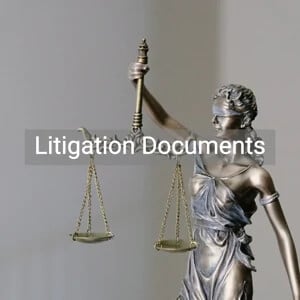Insurance Documents


Insurance documents relate to insurance applications, policies, claims, and other related documentation. As each insurer would have its own documentation and claim forms. The documents under this category generally relate to the notice given to the insurer for a potential insurance claim in court.
A Notice to Insurer is to be filed when Plaintiff commences proceedings against Defendant. For example, in relation to a road traffic accident, a notice would be filed by Plaintiff against Defendant for damages for personal injuries caused to Plaintiff by reason of negligence and /or breach of common duty of care on Defendant.
Another common type of notice to the insurer is for work-related injuries. Plaintiff seeks from Defendant damages for personal injuries caused to Plaintiff by reason of negligence and/ breach of statutory duties and/or breach of implied terms of the employment contract and/or breach of employer's duty of care.
The insurer is to take further notice that at the time of the accident/injuries the said Defendant was insured by the Insurer. A sealed copy of the Writ of Summons is filed with the document.
The insurance claim is a request to the insurer to make payments to compensate the insured for financial losses of the insured or third parties protected under the insurance. The individual or group pays the insurance premium in consideration for the insurance policy between the insured and the insurer. An insurance claim is a formal request made by an insured to the insurer for compensation for an insured loss or a policy event. The insurer confirms the claim, and once the claim is agreed, it will pay compensation to the insured or on behalf of the insured to the beneficiaries / third parties protected under the insurance.
Common insurance coverage ranges from:
It is common for a third-party beneficiary to make a claim on behalf of the policyholder, but usually, only the person listed on the policy is entitled to the claim amount.
Remember that it is important to file a claim within the allotted time. If the claim is not submitted within the deadline, the insurer may not be able to consider the claim.
Basic information required (additional information may be required, depending on the nature of the claim):
For large policies, it may require an in-depth investigation by the insurer to ensure that no contractual exclusion would apply, such as suicide, or death relating to criminal activity.
Basic information required (additional information may be required, depending on the nature of the claim):
Basic information required (additional information may be required, depending on the nature of the claim):
Basic information required (additional information may be required, depending on the nature of the claim):
Basic information required (additional information may be required, depending on the nature of the claim):
If there is any litigation in court, the insurer will generally take over the court process and the insured should not make an admission to liability (or may lose the claim).
Basic information required (additional information may be required, depending on the nature of the claim):
The insurer may get an adjuster to inspect and evaluate property damages based on the claim by the insured. After the adjuster verifies the losses, the insurer would compensate the insured or a third party under the policy.
Although one would be compensated for the loss by making a claim on the insurance, for property accident insurance, such as vehicle or household insurance, making a claim will increase the future insurance premiums. One will need to balance the benefits of making a claim with the potential increase in insurance premiums before making a claim.
For vehicle insurance, if the claim is based on losses caused by the insured, the premium will almost certainly rise. On the other hand, if the insured is not at fault, then the premium may not rise. For example, if the car was hit by a reckless driver running a red light.
For property and causality insurance policies, the number of insurance claims has a direct impact on your rates, regardless of the scope of the accident or who is at fault. The larger the number of claims, the more likely it is that the premium will rise. If the claim is excessive, the insurance company may not be willing to renew the insurance.
It's also important to consult the insurance agent/broker about the insurance policy before filing a claim. A good principle is to make a claim only in the event of a catastrophic loss, which is really the purpose of having insurance in any case. It is generally not worth claiming for a small scratch on the car, or a door handle that came loose.





Not the right document?
Don’t worry, we have thousands of documents for you to choose from: